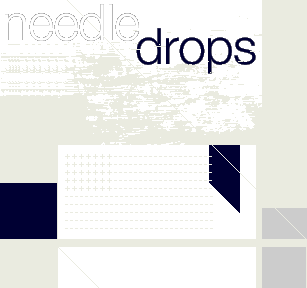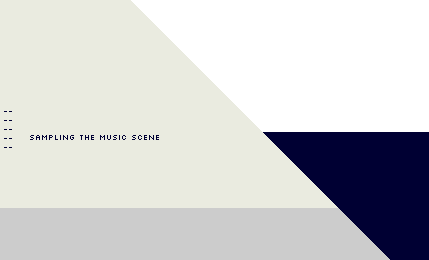


++ Contact Philip Sherburne ++
++ Recently ++
Tuesday, November 29, 2005 = The Stooges Unearthed (Again)
Tuesday, November 8, 2005 = Documenting Beulah And DCFC
Tuesday, November 1, 2005 = Out-Of-Control Rock 'N' Roll Is Alive And Well
Tuesday, October 25, 2005 = Just In Time For Halloween
Monday, October 3, 2005 = The Dandyesque Raunch Of Louis XI
Monday, August 15, 2005 = The Empire Blues
Tuesday, August 9, 2005 = David Howie's Sónar Diary
Monday, July 25, 2005 = Hot Sounds For Summertime
Monday, June 27, 2005 = Overcoming Writer's Block At Sónar 2005
Monday, June 4, 2005 = Cool New Sounds To Download Or Stream
++ Needle Drops Archives ++
View full list of Needle Drops articles...
|
|
 |
Friday, February 28, 2003
++ CCAC Wattis Institute's Mixtapes
When most of us, at least those under 40, consider the words "music" and "video" together, we most likely think first of MTV. Indeed, it's nearly impossible to consider the idea of music set to moving images outside the framework of a three-minute video clip interspersed with other such clips and an assortment of advertisements. In this context, the popular media regarded Michael Jackson's "Thriller" (1983) as an almost avant-garde exercise, only because it stretched out into a 13-minute long narrative piece.
My earliest memories of music videos are conditioned largely by MTV — and are colored equally by pre-adolescent battles with my parents, who, displaying the kind of Puritan work ethic that has always been at the core of my family's philosophical code, could conceive of nothing more frivolous, and therefore dangerous, than frittering away one's time watching ZZ Top ogle leggy shoe saleswomen. I was lucky enough to be exposed to the occasional clip that didn't pass muster with MTV's market-driven approach. Hence the wee-hour Night Flight turned me on to videos from the likes of Cabaret Voltaire. That cable program even aired feature-length audio-visual works like David Burbridge's 1981 new wave compendium Urgh! A Music War, which introduced me to Wall of Voodoo, Gary Numan, and Klaus Nomi. (What happened to Burbridge, anyway? IMDB lists Urgh! as his only film work.)
Of course, filmmakers had been visualizing popular music long before there were music videos. In the mid-'50s, at the birth of rock 'n' roll, films such as "Rock Around the Clock" (1956) combined music and celluloid. The Beatles had short films made in the late '60s that were aired on television to promote songs such as "Strawberry Fields Forever." Music documentaries and documentary-style films including Richard Lester's "A Hard Day's Night" (1964), D.A. Pennebaker's "Don't Look Back" (1967), Jean-Luc Godard's Sympathy for the Devil (1968), Michael Wadleigh's Woodstock (1970) and Albert and David Maysles' Gimme Shelter (1970) are only a few of the films that helped establish the union of rock and the moving image.
++ Now, CCAC Wattis Institute's exhibition Mixtapes, curated by Matthew Higgs, presents four recent video works that offer radically new ways of visualizing popular music. Running from blurry found footage to smoothly produced vignettes shot on a Hollywood soundstage, they're not necessarily technologically advanced: Chris Cunningham's music videos are far more stylish than anything glimpsed here. What's striking about Mixtapes is the way that it focuses largely on the lived experience of pop music and youth culture, identifying a pervasive melancholy beneath it.
This isn't entirely accidental: Higgs describes the exhibit as a series of "melancholic riffs on popular culture," exploring the agonized underside to moments more often portrayed for their celebratory, epiphanic nature. Shown individually for two weeks apiece on a wall-sized screen, the pieces coalesce into an occasionally contradictory whole that's strange, moving, funny, and visually arresting.
The starkest work in the series comes from fine art and fashion photographer Wolfgang Tillmans, best known for diaristic images of ravers and club kids around the world. In contrast to his still photos, which, informed by Nan Goldin's mixture of documentary and portraiture, celebrate youth culture through faces and evanescent moments, Lights (Body) examines only the robotic strobe lights of a Berlin nightclub, which flash and pivot in time to a deep house track by Air. It's a profoundly minimal piece: nothing ever really happens, and the montage simply cuts back and forth between a handful of static shots framing various details of the lights. Although Tillmans shot the piece over a series of weekends when the club was full, no people ever appear on screen. Their presence is suggested only by the clouds of dust — which, as the title subtly reminds us, is primarily composed of human skin — wafting through the lights.
The conceptualization of the abstracted body feels a little forced, perhaps just because "the body" has been such a buzzword in academic circles for the last decade. Still, the metaphor hints at an undeniable morbidity lurking at the center of trend-obsessed pop culture. On the surface this could be a video for MTV, but behind the style lurks something much darker. As the viewer inhabits Tillmans' gaze, one imagines a nightclub drug casualty left sprawled in a corner of the throbbing club, oblivious to his surroundings and fixated upon the repetitive mechanisms carving with light sabers through the dead air. In this context, to gaze only into the eaves while a crowded club rages on isn't only melancholy — it borders on the autistic, suggesting a frightening degree of detachment at the heart of the mass experience.
++ Mathias Poledna's Acualité looks like a scrap of rehearsal footage of some long-forgotten (and rightfully so) post-punk band, but it was made with actors on a Hollywood soundstage, borrowing some of Godard's own techniques from Sympathy for the Devil. Shot at close range against a nondescript black background, a charmingly incompetent, mixed-gender band painfully bashes away at a rudimentary set of chord changes (reportedly borrowed from a Red Krayola song). Nothing is steady, as the music stops and starts over and over; rotating Steadicam shots slowly churn, compressing the depth of field and sending instruments floating strangely through the foreground.
This is retro done down to the last rivet, with an eye for detail that even Williamsburg's Electroclash mavens haven't mastered. Striped tank tops, architectural hairdos, and bored looks born of a youth on the dole all perfectly capture the look of the late '70s and early '80s. But ultimately content trumps style: the real drama here is in the band's tense interactions as they work through the Sisyphean series of notes. Every action, even smoking a cigarette, seems tentative and perpetually interrupted, and an almost claustrophobic sense sets in as the camera rests upon the drummer's narrowed gaze, the guitarist's furrowed brow. Then, before you know it, the video is halfway through its second loop. This isn't Waiting for Godot, it's simply waiting for the coda.
++ Oliver Payne and Nick Relph, in their mid-20s, are the youngest artists in the exhibition, but their piece is in many ways the most sophisticated. (All the more intriguing, then, that one is an art-school dropout, and the other was expelled.) Mixtape, following videos the pair has made about skateboarding, club culture, and rural England, is neither narrative nor purely abstract, combining allegory and documentary, artifice and testimonial. The video, set to Terry Riley's masterpiece of cutup soul, "You're Nogood," is much more than the sum of its images, but it's impossible not to resort to a catalogue of scenes in describing it.
The piece opens with a scene reminiscent of Matthew Barney's Cremaster series, as a shirtless man holding sparklers stands in front of a cake decorated with the words, "Besht Friends" (sic). Before you can situate yourself, the montage carts you away on a very strange ride. Preteens in Green Day shirts and Thurston Moore hairdos rehearse in a rock band. A smiling Starbucks worker meticulously covers each of her facial piercings with blue electrical tape, suggesting the perpetual tension between individuality and corporatism. In an homage to Lee Scratch Perry, an old black man crawls on his hands and knees, banging on the ground with a ball-peen hammer. In a reference to Baudelaire's Parisian dandies, a hip-hop head poses on a street corner, outfitted in the requisite puffy down parka, holding a bejeweled turtle at the end of a leash.
There is found footage of hunters killing deer interspersed with a middle-aged couple making out in a darkened room decorated with stuffed animal heads. Throughout it all, Riley's tape-manipulated R&B jam tangles up in echo and delay, an effective complement to the visual aggregation, collapsing all these strands of real and imagined cultural moments into a knotty mess. Toward the end, two middle-aged country dancers battle a sweating raver beneath blinding strobes; the war of the generations finds its resolution in the final scene when a young man drops off his mother, an elderly redhead wearing a sundress and Easter bonnet and clutching a suitcase, at the edge of a graveyard, where she finds her own stone.
++ Mark Leckey's Fiorucci Made Me Hardcore, which opened the show, is at once the crudest and the most engrossing of the four pieces. The looping video patches together documentary footage from Northern Soul parties and early raves with shots of football casuals showing their plumage on the terraces, all set to a soundtrack of battered ambiance and club anthems that sounds mixed down from a 10th-generation dub. Urban tribes are Leckey's ostensible focus, given the way he lingers on the brand-name sportswear of the '70s and '80s and the implicit homoeroticism of young men's fashion rituals. But the real fascination is in the dancers he captures: amphetamined-up Northern Soul cowboys twirling like tops, ravers whose arms seem about to fly off their bodies, drugged-up ghosts that emerge from the darkness like coelacanths. These rituals where the body is disconnected from the mind, acted out in the embrace of the crowd, come to seem as alien as any Amazonian ayahuasca ceremony broadcast on public television. They suggest a raw, primal, even threatening instinct lurking in the heart of all youth culture. The fashions come and go, Leckey seems to say, but deep down we're all fucked up and alone.
|
| |
|